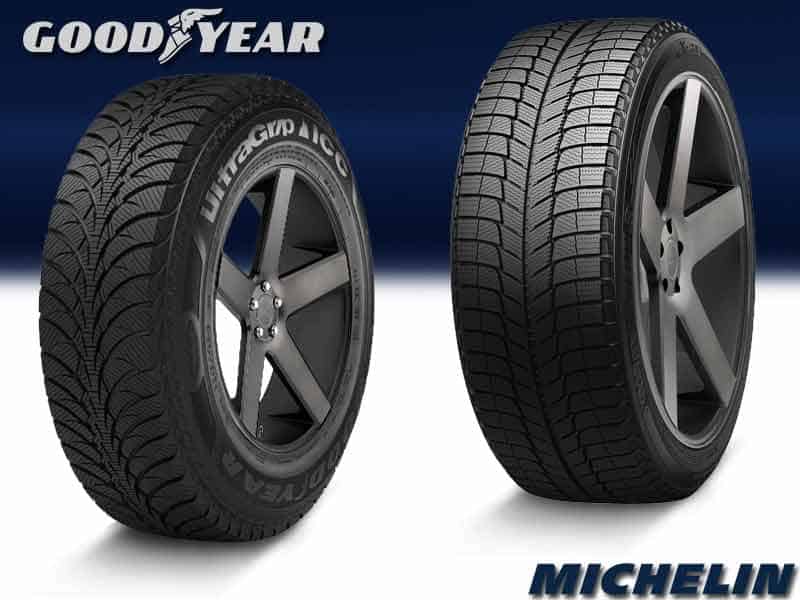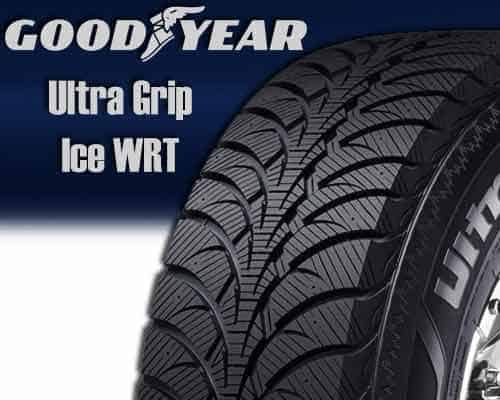Both of these are high-quality winter tires that offer incredible performance on both dry and wet roads, along with excellent traction on icy and snowy terrains as well.
However, upon comparing both these tires, we found that the Goodyear provides excellent hydroplaning resistance due to its wider longitudinal and lateral grooves. On the other hand, the narrower grooves and deeper sipes of the Ice Xi3 result in excellent traction on dry and wet roads.

Want to know which tire has a better handling performance among these two? Well, you can find it out in this comprehensive article!
Table of Contents
Comparing Goodyear Ultra Grip Ice WRT with Michelin X Ice XI3

Vs

Exclusively designed for harsh winter conditions, the Ultra Grip features two shoulders and only one central rib between them. The shoulders and the rib are separated by longitudinal and lateral grooves running around the tread. The sipes on the central part of the tread are also numerous. However, they are not as deep as that of its competitor. Furthermore, the shoulders are wide which makes a huge difference in its handling performance.
Just like its counterpart, the Michelin Xi3 also features a snow-friendly tread design that favors cold climatic conditions. This tire consists of two shoulders along with two central ribs separated by a narrower longitudinal groove running around its tread. It has numerous deep sipes found all over the tread. In addition to this, the shoulders are also compact and the lugs are closely positioned.
Grip Comparison
If we talk about Goodyear’s grip on dry roads, it has wider grooves comparatively, which reduces this tire’s grip significantly, as it has a lower contact patch.
Therefore, the braking distance of on dry roads increases as well. When it comes to the tire’s performance on wet surfaces, it is quite adequate. However, when compared to its competitor, it is still lesser. There are numerous sipes all over the tread pattern but they are not as deep as that of the Ice Xi3.
This leads to a higher braking distance on wet surfaces as well. However, the tire’s grip on soft snow increases due to its wider grooves. The deep biting edges prove to be incredibly helpful in maximizing the grip and as a result, the vehicle gets smooth mobility. On the other hand, the grip on icy roads is not considered reliable due to the lower contact patch of this tire.
In comparison, the Ice Xi3 consists of narrower grooves around its central ribs.
Due to the densely packed tread pattern, this tire gets a maximum contact patch and delivers splendid grip on dry roads. In addition to this, its performance on wet roads is also increased due to the numerous deep sipes found all over its tread pattern.
The sipes work excellently to provide sufficient grip and as a result, the braking distance on wet roads reduces.
However, when we tested this tire on snow, we saw a reduction in its grip as it does not have wide grooves to favor snowy conditions. But, this is not the case on icy roads. The numerous sipes and a higher contact patch works in harmony to provide excellent grip on the icy surface.
Handling Comparison
Overall, the handling performance of both these tires is almost the same but the Goodyear lags a bit behind its competitor due to its open shoulder design. The wider shoulder grooves of this tire results in compromising the handling of the vehicle while it turns over sharp edges. As a result, it will finish a lap on dry tracks in more time.
The handling on icy and wet surfaces is also reduced due to the lesser number of sipes found on the tire’s shoulders. However, when it comes to handling on soft snow, the Ultra Grip Ice displays maximum handling performance because of its wider grooves. The grooves help this tire a great deal by evacuating the snow that gets stuck inside it.
On the other hand, the Ice Xi3 delivers better handling on dry roads. The shoulders of these tires are compact and the shoulder lugs are also closely positioned. This increases the biting edge and as a result, the vehicle will require less time to complete a lap on dry roads. Furthermore, the sipes pattern on the shoulders also increases this tire’s handling performance on wet and icy tracks. However, we saw a drop in its performance when the vehicle was taken on snow. That’s because the tire’s lower void ratio does not prove to be effective in maintaining stability on snowy roads.
Comparison of Hydroplaning Resistance
The Ultra Grip Ice provides excellent hydroplaning resistance because of its wider longitudinal and lateral grooves. In addition to this, the sipes on the central part are also numerous. Therefore, the stability on flooded roads is increased and the chances of accidents are also reduced.
The narrower grooves of Michelin make it lose to its competitor in terms of hydroplaning resistance. Due to narrow grooves, this tire becomes incapable of evacuating water effectively from its grooves, and the stability of the vehicle on flooded roads is compromised.
Comparison of Rolling Resistance
The higher void ratio of the Ultra Grip Ice reduces its contact patch. As a result, the vehicle will require less force to maintain the motion. Since the tire’s rolling resistance is lower, its fuel efficiency will also increase.
In comparison, the contact patch of the Ice Xi3 is higher than its competitor, as a result, its rolling resistance will increase. Due to this, the fuel efficiency will be compromised.
Comfort Comparison
When it comes to comfort, Goodyear loses to its competitor because of its higher void ratio. Due to the wider grooves, there is more space for the entrapment of air particles. These air particles will strike back and forth against the groove walls. As a result, more noise will be produced and the comfort of this tire will be compromised.
Conversely, the Ice Xi3 is the clear winner of the comfort here. That’s because this tire features narrower grooves as compared to the Ultra Grip. So, there will be less space for the entrapment of air particles and the vehicle will produce less noise while moving at a high speed.
Durability & Treadwear
Talking about the durability and treadwear of the Goodyear, it features a winter-focused design and the central rib is also rigid and arrow-shaped. In addition to this, due to the lower rolling resistance of this tire, its tread will wear out slower.
On the other hand, the Ice Xi3 features a multi-cell tread pattern, making it a suitable tire for extreme cold weather. However, the rolling resistance of this tire is higher in comparison, as a result, its tread will wear out faster.
Price
Michelin Ice Xi3 features a higher price due to its excellent grip, handling performance, and comfort. On the other hand, if you are looking for a more affordable option, then you should opt for Goodyear. However, in the end, it all comes down to your personal preference.
Summary
- Both of them are winter tires.
- The dry and wet grip of the Ice Xi3 is better.
- The soft snow grip of the Goodyear is superior.
- The grip of Michelin on ice is more reliable.
- The dry and wet handling of the Michelin is more efficient.
- The rolling resistance of the Ice Xi3 is higher, leading to lower fuel efficiency.
- Michelin produces less noise while driving at high speed.
- The tread of Goodyear will wear out slower, making it more durable.
- Xi3 is a higher-priced tire.